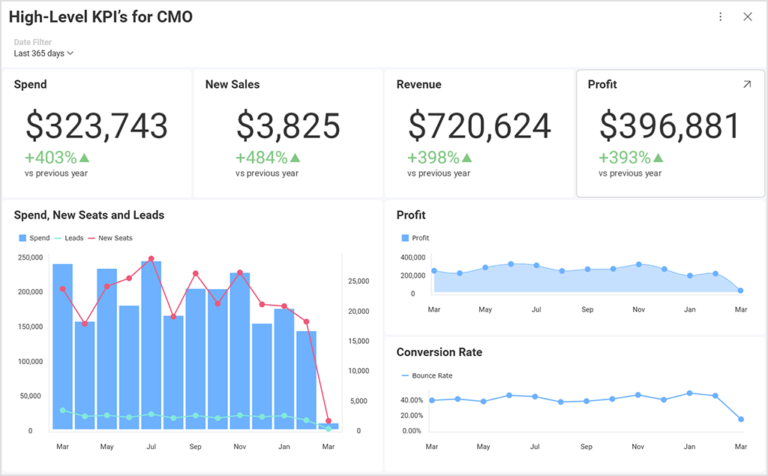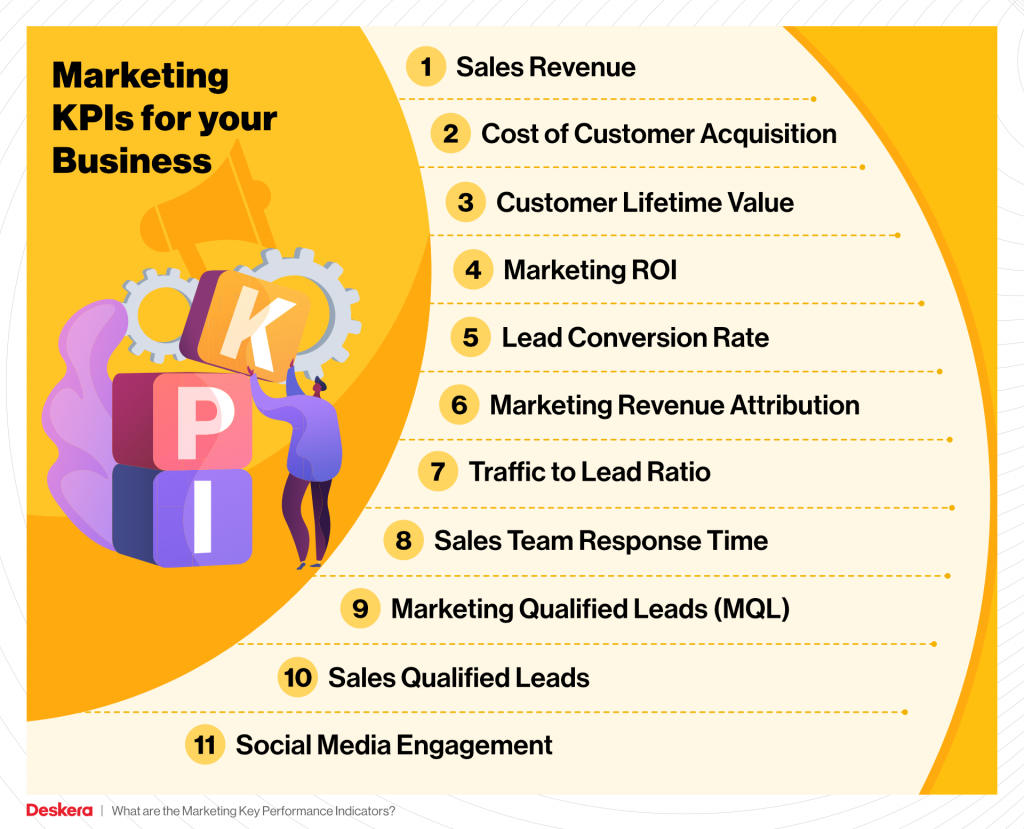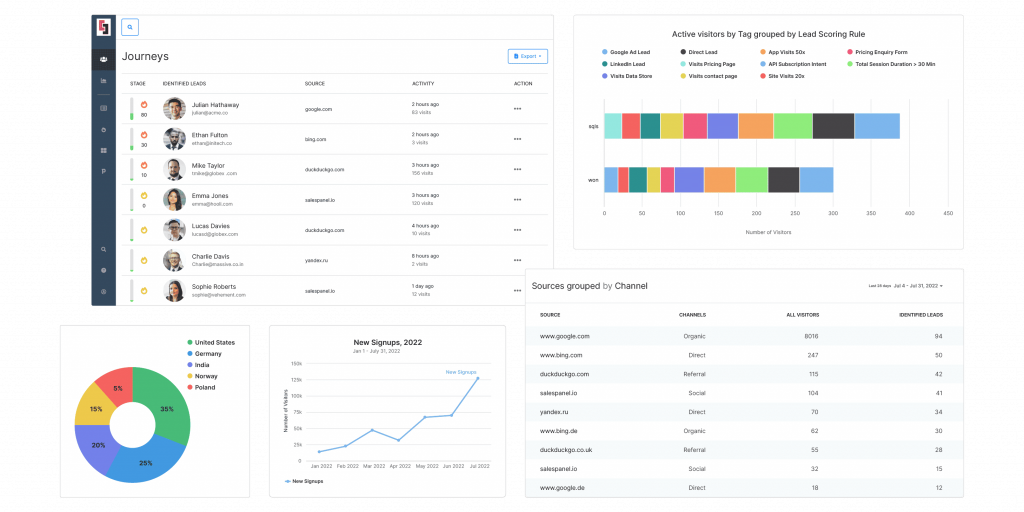CMO Dashboard: How Marketing Leaders Can Get 360° Views
A Chief Marketing Officer plays a pivotal role in a business’s growth. In more ways than one, CMOs are directly responsible for driving the revenue growth of a business.
But, too many things happen in marketing simultaneously — multiple campaigns, channels, ads, etc. and a CMO needs a tight grip on everything. But how can a CMO have a clear view of the big picture without missing any of the important details?
With a CMO dashboard!
A CMO dashboard enables all of this with its bird’s eye view of the big picture, the ability to track and monitor everything, attribute marketing efforts to results, and provide a glimpse into the small yet important details.
What is a CMO Dashboard?
A CMO (Chief Marketing Officer) dashboard is a centralized repository of data to provide a comprehensive overview of a company’s marketing performance. It gathers data from various marketing channels and presents it in a single interface.
The main purpose of a CMO dashboard is to help CMOs and marketing teams monitor and analyze key marketing metrics to analyze performance, improve campaigns, and identify revenue drivers.
It offers a visually appealing representation of data, using charts, graphs, and tables, to make it easy to understand, interpret and act on insights.
Revenue and ROI, conversion rates, traffic sources, engagement metrics, campaign performance, and customer acquisition and retention are some of the common metrics focused on in a CMO dashboard.
These metrics provide insights into the financial impact of marketing efforts, the effectiveness of different marketing channels, user engagement with marketing content, the performance of individual campaigns, and customer acquisition and retention rates.
CMOs can gain actionable insights and make data-driven decisions to optimize marketing strategies. Resource allocation can also be improved which in turn will boost the overall marketing performance.

Image Source: Slingshot
5 Ways a CMO Dashboard Helps Marketing Leaders?
You must be wondering how a CMO Dashboard achieves all the amazing things we mentioned earlier. Here’s a detailed explanation of how a CMO dashboard does it.
1. Data-Driven Decision Making
Yes, your marketing instincts are still very much important but data can help you make even better decisions by minimizing risks of failure.
A CMO dashboard presents key marketing metrics and performance indicators in a visually comprehensible format. Marketing leaders can quickly analyze the data and gain valuable insights into the effectiveness of marketing strategies and campaigns.
Thus, knowing the ins and outs, hows and whys of marketing efforts become effortless. This enables leaders to make informed, data-driven decisions to optimize marketing operations, allocate resources effectively and generate better revenue yields.
2. Performance Tracking
In today’s hyper-competitive market, waiting for a performance report at the end of every week can be limiting. To stay competitive and idenitfy opportunities fast, you need to stay on top of things at all times.
The CMO dashboard allows marketing leaders to track the performance of various marketing initiatives in real-time. They can actively monitor important metrics such as revenue, conversion rates, customer acquisition, and campaign performance.
This allows marketing leaders to fine-tune marketing operations proactively and make the most of unexpected opportunities that emerge. Moreover, knowing the small details also helps improve market understanding and overall decision-making.
3. Campaign Optimization
When it comes to marketing, there are always too many things to keep track of. This is especially true when you have multiple marketing campaigns running in parallel. Managing these campaigns without a CMO dashboard can be a tricky affair.
A CMO dashboard not only simplifies all of this but enables marketing leaders to fine-tune each marketing campaign to the finest detail. They can track metrics such as impressions, click-through rates, conversions, and cost per acquisition.
With this information at hand, it’s easy to identify which campaigns are delivering the best results and which need optimization. Data-driven decisions can then be taken to optimize and allocate resources to the most effective strategies.
4. Resource Allocation
How a business’s limited resources are allocated and utilized is a key determinant in the success and growth of that business. Thus, marketing leaders need to be careful about how resources are being allocated and to which campaigns.
The CMO dashboard provides visibility into the performance of different marketing channels, tactics, and campaigns. Marketing leaders effectively can determine which channels are generating the best results.
Having these insights into marketing operations enables better decision-making in terms of the allocation of resources. Focusing on the most impactful channels and campaigns can thus result in the maximization of Marketing ROI.
5. Alignment with Business Goals
Your business as a whole has a general directional focus. This means all business functions must align with this direction, including marketing. Producing good results means nothing if they’re misaligned with business goals.
A CMO dashboard enables marketing leaders to assess how marketing activities align with overall business objectives. Monitoring metrics such as revenue generation, ROI, and customer acquisition ensures that marketing efforts are contributing to the company’s growth and profitability.

Image Source: Deskera
10 KPIs That CMOs Need To Track
1. Conversion Rate:
This KPI measures the percentage of website visitors or leads that take a desired action, such as making a purchase, filling out a form, or subscribing to a newsletter. Tracking the conversion rate helps assess the effectiveness of marketing campaigns and the user experience on the website.
2. Customer Acquisition Cost (CAC):
CAC measures the average cost incurred to acquire a new customer. It considers the total marketing and sales expenses divided by the number of new customers acquired. Tracking CAC helps evaluate the efficiency of marketing efforts and optimize budget allocation.
3. Customer Lifetime Value (CLV):
CLV measures the total revenue a customer generates throughout their relationship with the company. It helps determine the long-term value of acquiring and retaining customers.
4. Return on Investment (ROI):
ROI assesses the profitability of marketing campaigns by comparing the revenue generated against the costs invested. It helps marketing leaders understand the financial impact of their initiatives and optimize resources to achieve the highest return.
5. Net Promoter Score (NPS):
NPS measures the likelihood of customers recommending a company or its products/services to others. It provides insights into customer satisfaction and loyalty.
6. Customer Retention Rate:
This KPI measures the percentage of customers who continue doing business with the company over a specific period. Tracking customer retention helps marketing leaders understand customer loyalty, identify potential issues, and implement strategies to improve customer satisfaction and retention.
7. Marketing Qualified Leads (MQLs):
MQLs are leads that meet specific criteria, indicating they are more likely to become customers. Tracking the number and quality of MQLs generated helps marketing leaders assess lead generation efforts and align marketing and sales teams.
8. Website Traffic and Sources:
Monitoring website traffic and its sources provide insights into which marketing channels and campaigns are driving the most visitors. It helps marketing leaders understand audience behavior, optimize marketing channels, and allocate resources effectively.
9. Revenue:
Tracking overall revenue generated is crucial to understanding the direct impact of marketing efforts on the company’s bottom line. It helps measure the effectiveness of marketing campaigns and overall revenue growth.
10. Customer Churn Rate:
The churn rate measures the percentage of customers who discontinue their relationship with the company over a specific period. Tracking churn rate helps marketing leaders identify retention challenges and take proactive measures to reduce customer attrition and increase revenue retention.
CMO Dashboard Examples
Here we will take a look at a few examples of CMO dashboards. This will help you understand what your CMO dashboard could look like.
Geckoboard

Image Source: Geckoboard
Slide Team

Image Source: Slideteam
Adriel

Image Source: Adriel
Datapine

Image Source: Datapine
Klipfolio

Image Source: Klipfolio
Salespanel Dashboard for CMOs
While Salespanel is not fundamentally a CMO dashboard tool, it aggregates rich marketing analytics data for B2B businesses that use their website to acquire leads and customers. How? Salespanel captures visitors from different channels, attributes the sources correctly, and tracks these visitors in real-time. The product also reveals B2B accounts from your website (even if they have not signed up!) to help you understand how different accounts engage with your funnel. When a lead finally does sign-up (using forms, live chat, lead magnets, etc.), Salespanel captures the contact information automatically without integration. All of these data points are properly tracked and presented to you in an analytical dashboard that has been designed specifically for B2B businesses.
What makes a good CMO dashboard? Powerful marketing analytics capabilities? Customization of the dashboard? Advanced features and sharing capabilities? A good CMO dashboard needs all of these and Salespanel has it all!
With Salespanel, you will be able to unearth valuable insights from the data gathered from your website, all of which can be presented visually in a CMO dashboard that marketing leaders can customize as per their liking.
You also can share your dashboards with others in your team. This will help get everyone on the same page and collaborate more efficiently toward realizing business goals.
With one-click real-time report generation, Salespanel has you covered. Want to learn more? Visit our website.

Salespanel Dashboards
Sell more, understand your customers’ journey for free!
Sales and Marketing teams spend millions of dollars to bring visitors to your website. But do you track your customer’s journey? Do you know who buys and why?
Around 8% of your website traffic will sign up on your lead forms. What happens to the other 92% of your traffic? Can you identify your visiting accounts? Can you engage and retarget your qualified visitors even if they are not identified?



